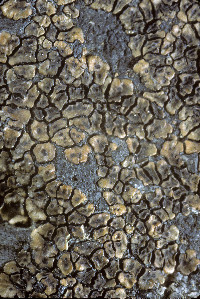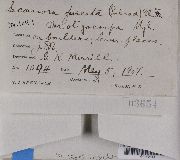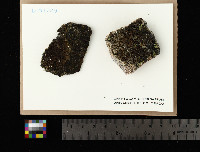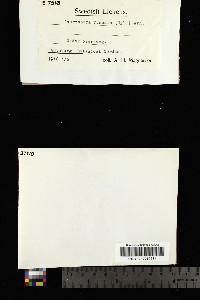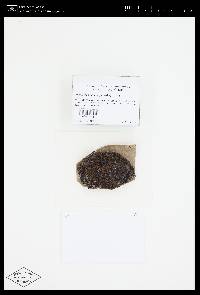
Consortium of Lichen Herbaria
- building a Global Consortium of Bryophytes and Lichens as keystones of cryptobiotic communities -
- Home
- Search
- Images
- Species Checklists
- US States: O-Z >
- US National Parks
- Central America
- South America
- US National Parks
- Southern Subpolar Region
|
|
|
|
Family: Acarosporaceae
Brown Cracked Lichen
[Acarospora cartilaginea H. Magn., moreAcarospora squamulosa f. albomarginata (Cromb.) A.L. Sm., Acarospora squamulosa f. marginata Cromb., Acarospora squamulosa f. squamulosa (Ach.) Trevis., Acarospora squamulosa var. squamulosa (Ach.) Trevis., Acarospora veronensis var. fuscata (Nyl.) Arnold, Lecanora badia var. fuscata Ach., Lecanora fuscata Röhl., Lecanora fuscata var. fuscata Nyl., Lecanora fuscata var. pelioscyphoides Nyl., Lecanora fuscata var. peliscyphoides Nyl., Lichen fuscatus Schrad. nom. cons.] |
Nash, T.H., Ryan, B.D., Gries, C., Bungartz, F., (eds.) 2007. Lichen Flora of the Greater Sonoran Desert Region. Vol 3. Thallus: areolate, indeterminate, overall up to 10 cm wide areoles: angular or irregular, 0.3-1.5(-3) mm in diam., usually less than c. 0 6 mm thick, generally contiguous, often imbricate, usually in large patches, rarely lobed (Sonoran area) or lobed; rim: down-turned, usually black upper surface: pale or dark yellowish brown, dull, usually flat to slightly convex, sometimes heavily fissured, epruinose upper cortex: paraplectenchymatous to anticlinally prosoplectenchymatous; cells: angular or subglobular, (2-)3-4 µm wide, in ±vertical rows, 20-33 µm thick; syncortex: c. 10 µm thick; eucortex: dark pigmented layer above and 10-17 µm thick, hyaline below and 10-17 µm thick lower cortices: continuous with upper cortex; c. 20 µm thick algal layer: even medulla: white, intricately prosoplectenchymatous lower surface: black attachment: broad, with rhizohyphae up to 5 µm in diam., without a stipe Apothecia: usually one per areole, punctiform to filling whole areole disc: reddish brown, rough parathecium: c. 20 µm thick, usually expanding to c. 50 µm at top of fully dilated disc epihymenium: dark brown, c. 10 µm thick hymenium: hyaline, 70-80(-110) µm tall; paraphyses: 1.8- 2 µm wide at base, spreading in water, with apices up to 3(-4) µm wide and sometimes with pigment hoods subhymenium: pale yellow or hyaline, 10-40 µm thick; hypothecium: c. 20 µm thick asci: clavate, 60-80 x 10-17µm, 100+-spored ascospores: hyaline, simple, broadly to narrowly ellipsoid, 4-5(-7) x 1-1.5(-2.1) µm Pycnidia: not observed Spot tests: UV-, KC+, C+ red cortex (best seen under microscope!) Secondary metabolites: gyrophoric acid. Substrate and ecology: on acidic rocks, low to high elevations World distribution: North America and Europe Sonoran distribution: southern California and Arizona. Notes: Acarospora fuscata is uncommon in Sonoran area, where it usually occurs in inland areas at mid-elevations on north slopes or along shaded watersheds. Many C+ red species are erroneously identified as A. fuscata, as most reports of A. fuscata from the southwestern US actually proved to be other species. Acarospora fuscata has an areolate thallus, and other species usually form verrucae or squamules. Specimens growing on uneven surfaces are sometimes incorrectly determined as A. thamnina, but these specimens do not have a well-developed stipe or rough black discs, and they are not glossy. Lobed areoles are seen in some eastern North American specimens, but such specimens are generally absent in the Sonoran area. |
|
|
|
Powered by Symbiota








